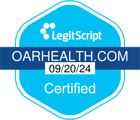Medication To Quit Alcohol: Why So Underutilized?

In This Article
Medications can help people reduce or stop drinking, but many don’t know about them. Prescription medication to treat alcohol use disorder (AUD), like naltrexone, has been FDA-approved for almost thirty years. But despite FDA approval and numerous studies backing the safety and efficacy of a medication that can help people reduce or stop drinking, it remains vastly underutilized.
Excessive alcohol use in the United States is a growing emergency, leading to approximately 178,000 deaths per year (1). COVID-19 exacerbated alcohol use for many, causing 25% of people to drink more to cope with pandemic-related stress (2). Amidst rising alcohol issues, all types of treatment for AUD are underused. Medication-assisted treatment is even more rare.
Despite its decades-long availability, awareness of naltrexone remains low. Many people leave their doctor’s office without knowing that it exists. A 2019 study found that only 1.6% of people with AUD in the US used medication despite an estimated 14.1 million adults who had the condition (3).
The American Psychological Association’s (APA) clinical practice guidelines for the pharmacological treatment of AUD encourage the use of medication when clinically appropriate. Naltrexone can have powerful impacts on alcohol use. The medication can:
- Reduce the euphoric effects of alcohol
- Reduce cravings for alcohol
- Reduce binge drinking (
- Lead to sustained reductions in drinking
Stigma In Getting Treatment For AUD
When pursuing treatment for AUD, people may experience public stigma and private shame. Stigma is one of the most significant reasons people don’t seek the care they need. Publicly, this may manifest as someone fearing judgment from healthcare providers when they disclose alcohol use problems. Personally, stigma may look like someone feeling like they have failed, causing them to delay treatment or keep the issue to themself.
Lack Of Awareness
Many people simply do not realize that medication for AUD exists. A 2015 study found that only 20% of people who abuse alcohol will receive any form of treatment, including rehabilitation or medication (6). A study that examined 7231 Canadians with moderate-to-severe AUD found that only 5% of people received medication for AUD for the minimum recommended time (7).
Resistance From Doctors
A primary care provider (PCP) can be instrumental in someone’s recovery by providing routine screenings for AUD, diagnosing AUD, and prescribing medication. People are more likely to mention a problem to their PCP than make an appointment with a specialist. Additionally, doctors can help identify a problem someone doesn’t know they have.
PCPs can help bridge gaps in treatment and prevent people from falling through the cracks. However, doctors seldom prescribe medication for AUD despite how efficacious it is (3).
Research finds that while medication can work well in conjunction with other methods, such as psychotherapy or Alcoholics Anonymous (AA), it is also effective when taken alone. A panel consisting of the National Institute of Alcohol Abuse and Alcoholism (NIAAA) and the Substance Abuse and Mental Health Services Administration (SAMHSA) found that doctors may have an incomplete understanding of how medications for AUD work. Doctors may also exhibit resistance to treating a substance abuse disorder with another substance, even though it’s not addictive (8).
Misunderstandings About Who Medication Is For
In addition to a lack of knowledge that medications for AUD exist, people may misunderstand who they are for. Individuals may think their disorder needs to be “bad enough” to take medication or that it needs to mirror depictions of AUD in movies. This can lead people to think AUD only looks the most extreme and medication is a dire approach. In reality, naltrexone can be appropriate for those with mild, moderate, or severe alcohol misuse.
People may also think that if they struggle with binge drinking or excessive drinking at certain times, medication won’t be effective. There is some evidence that naltrexone can be helpful when taken as needed to reduce binge drinking (9). One study looked at individuals who took one tablet of naltrexone before an event that caused drinking cravings and found that even six months later, individuals were able to drink less.
Lack Of Access
A 2023 study found that for those in remote or rural areas, rates of access to medication for AUD are diminished compared to those in larger cities (10). The study also found that people who already had mental health care were more likely to receive naltrexone. Most insurance plans cover naltrexone, but without insurance, someone may experience the cost of medication as a reason that blocks access.
Concern For Side Effects
Learning that a medication has side effects may dissuade people from accessing care. People may also fear adding a medication to their treatment plan. It’s important to know that naltrexone does not cause mental or physical dependence. The main contraindication for prescribing naltrexone is that someone cannot take it if they are currently on opioids.
The side effects of naltrexone are generally mild. They include the following.
- Nausea
- Headache
- Sleep disturbances
- Low energy
- Cramps
- Anxiety or nervousness
- Joint pain
There’s no magic pill for addiction, except there is one that can significantly help. From stigma to misunderstandings about how medicine works and who it’s for, many factors bar people from receiving life-changing alcohol use support. Individuals considering medication for AUD can feel assurance from the years of time-tested data that supports the efficacy and safety of naltrexone.
Not enough people utilize medication that could help them reduce or stop drinking, thereby reducing alcohol-related deaths and enhancing quality of life. At Oar Health, we’re on a mission to change that. Effective treatment for AUD exists, and it’s just a click of a mouse away.
About The Author
Xenia Ellenbogen (she/they) is a journalist specializing in health, mental health, and wellness. Her writing has appeared in publications such as Everyday Health, Well+Good, Rewire News Group, Prism, and more.






